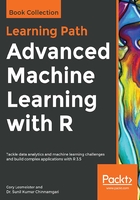
Data creation
In this section, I'll discuss how I created the dataset used for this chapter and provide insight into the features and the class labels we'll endeavor to predict. The data is available on GitHub at https://github.com/PacktPublishing/Advanced-Machine-Learning-with-R/blob/master/Data/sim_df.csv:
- Let's get our libraries and data loaded:
> library(magrittr)
> install.packages("glmnet")
> install.packages("caret")
> install.packages("classifierplots")
> install.packages("DataExplorer")
> install.packages("InformationValue")
> install.packages("Metrics")
> install.packages("ROCR")
> install.packages("tidyverse")
> options(scipen=999)
> sim_df <- readr::read_csv('sim_df.csv')
The dataframe is 10,000 observations of 17 variables, consisting of 16 input features and 1 response. I created this dataset using the twoClassSim() function from the caret package. The full code with seeds is available in the online code, allowing you to make changes and create whatever data you would like to explore. A full explanation of your options in creating your own set is available in the function's help.
- Now, let me go over the column names and tell you what this is all about:
> colnames(sim_df)
[1] "TwoFactor1" "TwoFactor2" "Linear1" "Linear2" "Linear3" "Linear4"
[7] "Linear5" "Linear6" "Nonlinear1" "Nonlinear2" "Nonlinear3" "Noise1"
[13] "Noise2" "Noise3" "Noise4" "Class" "random1"
First of all, the TwoFactor features are correlated with each other and slightly predictive of the response, y. Five of the six linear features, the three non-linear features, and the feature named random1 might have some predictive power. The four noise features should have absolutely no predictive power unless by pure chance. Also, the Linear5 and Linear6 features are highly correlated. I created that relationship to help point out how the different methods will handle it.
- The y labels are somewhat imbalanced, roughly 70/30:
> table(sim_df$y)
0 1
7072 2928
- The data isn't too wide to include all of it in a correlation plot:
> DataExplorer::plot_correlation(sim_df)
The output of the preceding code is as follows:

The plot confirms visually what I described previously. The highest correlation is between Linear5 and Linear6. What we can do is eliminate one of the pairs of highly correlated features, which I did in Chapter 2, Linear Regression. In this instance, we'll keep both in and let the algorithms handle it.
This data is fully prepared for modeling in this chapter, so let's begin.